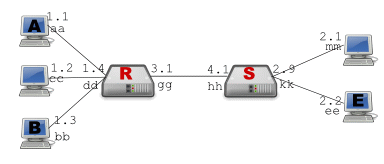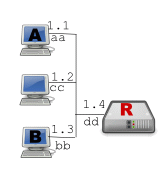
if statement, or
conditional operator, write an expression (in the programming
language of your choice) for calculating the length of the
"short" frame/fragment, given the number of frames/fragments
(in a variable named numberOfFrames), the IP header
length (in a variable named ipHeaderLength), the TCP
header length (in a variable named tcpHeaderLength),
and the HTTP payload length (in a variable named
httpPayloadLength).
if statement, or
conditional operator, write an expression (in the programming
language of your choice) for calculating the number of
IP fragments in terms the payloadLength,
ethernetLength and headerLength.
(Note: You can ignore the details of TCP for this question
and focus on IP fragmentation.)

For this question, the device R is both a link layer switch (for aa, bb, cc, dd, and gg) and a network/internetwork layer router. Similarly, the device S is both a link layer switch (for ee, hh, kk, and mm) and a network/internetwork layer router.
Suppose that an application bound to port 2801 on workstation A wants to use UDP to send the message "Dude!" to an application bound to port 1932 on workstation E. Suppose further that the header for the transport layer protocol contains only the from port and the to port, the header for the network/internetwork protocol contains only the from IP address and to IP address, and the header for the physical/link layer protocol contains only the from MAC address and the to MAC address.
Further, suppose that an application on E wants to open a TCP connection bound to port 3401 on 2.2 to an HTTP server bound to port 80 on 1.3. In addition, suppose that the transport layer protocol now includes an 8-bit field in which the lowest-order bit is the ACK field, and the next lowest-order bit is the SYN field.

rather than a star topology. What issues would arise and at what layer of the protocol stack? In other words, what protocol(s) did not have to be used in the star topology that will have to be used in the bus topology?
Copyright 2013